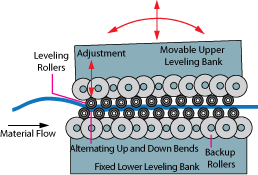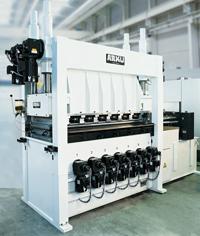- FMA
- The Fabricator
- FABTECH
- Canadian Metalworking
Categories
- Additive Manufacturing
- Aluminum Welding
- Arc Welding
- Assembly and Joining
- Automation and Robotics
- Bending and Forming
- Consumables
- Cutting and Weld Prep
- Electric Vehicles
- En Español
- Finishing
- Hydroforming
- Laser Cutting
- Laser Welding
- Machining
- Manufacturing Software
- Materials Handling
- Metals/Materials
- Oxyfuel Cutting
- Plasma Cutting
- Power Tools
- Punching and Other Holemaking
- Roll Forming
- Safety
- Sawing
- Shearing
- Shop Management
- Testing and Measuring
- Tube and Pipe Fabrication
- Tube and Pipe Production
- Waterjet Cutting
Industry Directory
Webcasts
Podcasts
FAB 40
Advertise
Subscribe
Account Login
Search
New generation of levelers tames high-strength steels
Levelers correct defects like coil set, crossbow, camber
- By Sascha Becker
- December 11, 2007
- Article
- Bending and Forming
The material requirements in the stamping industry have changed to meet industry demands. The increasing use of high-tensile-strength materials, mainly in the automotive industry, makes leveling more essential than ever. To obtain adequate flatness in high-strength steel (HSS) coil, higher leveling forces and new concepts are needed.
Why are next-generation levelers required to tame HSS? To understand this connection, it is necessary to understand coil defects. Cold-rolled strip defects are coil set, crossbow, twist, and edge camber.
Defects
Coil set and crossbow occur as a result of the strip-coiling process. Coiling causes a lengthwise stretching of the inside surface relative to the outside surface of the stock. The lengthwise stretching causes a widthwise contraction, resulting in crossbow. Other defects are twisted strip and edge camber. Generally, edge camber occurs only in narrow strips.
Defects in wide strips are wavy edges, coil breaks, and center buckles, although wavy edges and center buckles can occur in thin strip also. As the material is cold-rolled, deflections in the rolling mill thin some areas of the strip cross section more than others. This also elongates those thinner areas of the strip, causing a waviness in the longer areas. To remove these material tensions, leveling is needed.
How Levelers Work
Straighteners and levelers are precision machines designed to correct these defects in coil and plate (see Figure 1). Four main applications for levelers and straighteners are coil stamping press feeding lines, coil roll forming lines, and coil cut-to-length lines; part levelers are used to level parts and plate blanks.
The underlying principle in roller leveling is the selective elongation of portions of the strip, so that shorter areas are proportionally stretched to the material's yield point to achieve uniform strip fiber length. This is done by subjecting the strip to a series of up and down bends over small radii as it passes through the machine in such a way that the shorter strip fibers travel longer path lengths. As the strip proceeds toward the exit of the machine, the depth of these up and down bends is gradually reduced to eliminate the curvature caused by the severe bending at the machinery entry. When all the fibers are nearly the same length, the strip is flat, or level.
Choose the Correct Leveler Types
The most important aspect of achieving satisfactory leveling results is the careful choice of the machine for the task. Requirements vary, depending on the application and material thickness.
The simplest machine is a flattener. It is equipped with a few large-diameter rolls. Flatteners cannot produce the needed amount of deformation to achieve good flatness in HSS because small-diameter rollers, narrow roller spacing, and good support of the leveling rollers with backup rollers are essential for good flatness. Therefore, flatteners' usefulness is limited.
Nowadays three kinds of leveling machines—straighteners, precision straighteners, and high-capacity levelers—have been developed to meet the demands of HSS.
All three of these machine designs are characterized by good support of the leveling rollers, narrow roller spacing, bank adjustment, and a drive system that can achieve the leveling requirements.

Figure 1Strip defects can be eliminated with straighteners or levelers, such as this four-high precision straightener.
Straighteners. These are equipped with seven to nine large-diameter leveling rollers. They are used mainly in stamping press feeding lines. Although the coil line often is only a fraction of the entire installation investment, without a reliable coil line, economical production is not possible.
Precision Straighteners. These are needed when flatness requirements are higher. They can eliminate not only defects like coil set, but also crossbow and twist. Precision straighteners are characterized by nine to 21 driven leveling rollers and backup rolls (see Figure 2).
They also can be equipped with intermediate work rolls. This roll configuration is also known as six-high (see Figure 3). The intermediate work roll set eliminates roll wear on the leveling rollers that might otherwise mark soft, highly polished, and sensitive surfaces or surfaces that must be scratch-free, such as auto bodies.
Today's precision straighteners can be equipped with quick-cassette-changing systems for the leveling rollers to help prevent them from marking the surface with dirt particles. A precision straightener with a cassette-changing system is designed to produce constant leveling results with short downtimes. It also enables a wider leveling range by using several cassettes with different roller diameters.
High-capacity Levelers. This third type of coil leveler is suitable for tasks requiring the highest degree of flatness (see Figure 4). Each leveling roller is supported by backup rollers extending from the entry to the exit of the machine. Each backup roller supports a small part of each leveling roller. The lower backup rollers can be adjusted up or down. So the nest between the upper and lower leveling rollers can be controlled at different points across the complete width of the leveler. Defects like center buckles and wavy edges can be eliminated by adjusting the leveler rollers.
High-tensile-strength Materials Drive New Features
Optimum Support. The higher leveling forces that are needed to level high-tensile-strength materials also affect the machine design and the leveling rollers. A sturdy design with optimal support of the leveling rollers is needed, both to achieve the required leveling results and for installation durability.
Bank Adjustments. The higher leveling forces required to form the high-tensile-strength strip can be achieved with narrow roller spacing. That is why modern levelers are equipped with bank adjustments. Because of the machine design, bank adjustments help make minimal roller spacing possible.
Drive Systems. In addition, a powerful drive system is very important for the efficiency of the leveler and the leveling results, so new drive systems have been developed for leveling rollers. One such drive system helps to reduce the torque required by individual cardan shafts, which boosts the machine's performance range. These drive system advancements result in reduced wear on the machine and prolonged service of the straightening rolls.
Hydraulic Parts Levelers for HSS
Parts Levelers. To level thick plates and parts used in the construction, machinery, electrical, and aviation industries, parts levelers are needed. For high-tensile parts, such as saw blades and clutch disks, hydraulic parts levelers produce the best results, because they can build up high leveling forces (see Figure 5). During leveling, a nonhydraulic leveler acts by enlarging the gap between the upper and lower leveling banks, because of mechanical tolerances. A servo-hydraulic gap control detects the widening of the gap and reacts by building up a counterforce with hydraulic cylinders.
Quick-change Capabilities. To reduce downtime, coil-changing time must be reduced, and this can be achieved with modern automation technology. Modern hydraulic parts levelers also are equipped with quick-change leveling rollers.

Figure 2Precision straighteners in coil lines provide excellent flatness results and process stability for the whole installation.
A new-generation feeder/straightener with a jaw-opening straightening unit saves time during coil change and makes the leveling rollers more accessible for cleaning. It is possible to clean or change the leveling rollers in a few minutes.
Overload Protection. When leveling thick plates up to 2 inches thick, high forces can occur on both the leveler and the sheet metal. A wrong adjustment of the machine can cause several components of the leveler to be overloaded. Modern hydraulic parts levelers have overload protection to eliminate this risk. If the forces on the leveler become too high, the hydraulic parts leveler stops, the leveling unit opens, and the sheet metal part then can be backed out easily.
About the Author
Sascha Becker
Siemensstrasse 11
Baden-Baden, OH 76532
49-7221-5009-35
subscribe now

The Fabricator is North America's leading magazine for the metal forming and fabricating industry. The magazine delivers the news, technical articles, and case histories that enable fabricators to do their jobs more efficiently. The Fabricator has served the industry since 1970.
start your free subscription- Stay connected from anywhere

Easily access valuable industry resources now with full access to the digital edition of The Fabricator.

Easily access valuable industry resources now with full access to the digital edition of The Welder.

Easily access valuable industry resources now with full access to the digital edition of The Tube and Pipe Journal.
- Podcasting
- Podcast:
- The Fabricator Podcast
- Published:
- 04/16/2024
- Running Time:
- 63:29
In this episode of The Fabricator Podcast, Caleb Chamberlain, co-founder and CEO of OSH Cut, discusses his company’s...
- Trending Articles
How to set a press brake backgauge manually

Capturing, recording equipment inspection data for FMEA

Tips for creating sheet metal tubes with perforations

Are two heads better than one in fiber laser cutting?

Hypertherm Associates implements Rapyuta Robotics AMRs in warehouse

- Industry Events
16th Annual Safety Conference
- April 30 - May 1, 2024
- Elgin,
Pipe and Tube Conference
- May 21 - 22, 2024
- Omaha, NE
World-Class Roll Forming Workshop
- June 5 - 6, 2024
- Louisville, KY
Advanced Laser Application Workshop
- June 25 - 27, 2024
- Novi, MI




























